Cromwell Cider Apples
Hand picked from August through to December
Cromwell Apple Orchard
Our orchard has been in the family now for 5 generations, I’m the third and nearing retirement. It was planted for producing fruit not cider and that legacy of layout still remains with us today albeit all fruit now goes for Cider. Trees vary in age from about 130 years old down to 1 year as older trees succumb to age and are replaced. This means we are tied to the layout of trees decided back in the 19th century and have trees that are laid out and pruned more for hand picking. Our operation therefore is more traditional and selective than highly mechanised and mass production methods of our West Country counterparts. Our apples are also different using mainly dessert and culinary apples making our cider truly traditional and East Anglian in style.
The apple varieties we use are:
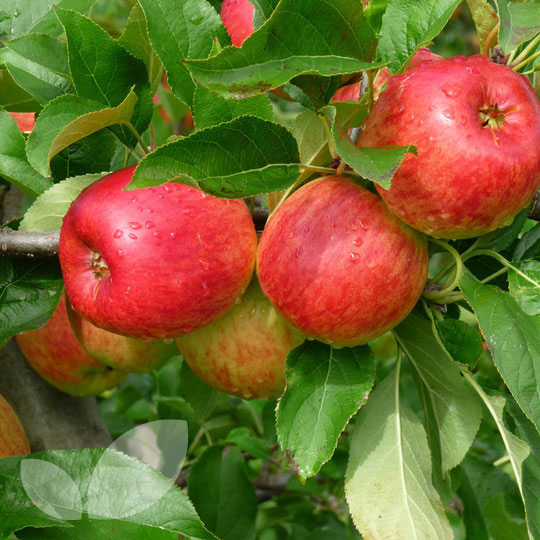
Ambassy
A new apple to Cromwell with young trees only just starting to crop but showing great promise. It’s a heavy regular cropping apple with pale yellow fruits flushed with crimson and fruiting in late September/early October. The apples are large with crisp flesh which is sharp with a mix of flavours, a honey-like sweetness with a hint of aniseed.

Ashmead’s Kernel
Our Ashmead Kernel trees were set about 15 years ago when we sold apples more than making cider. Ashmead’s are a green russeted apple, originating in the 1700s with an appearance that is not especially attractive and is not particularly suitable for juicing. They do add good flavours to the cider so we will be keeping a few but the bulk of the trees are being regrafted to Ambassy.
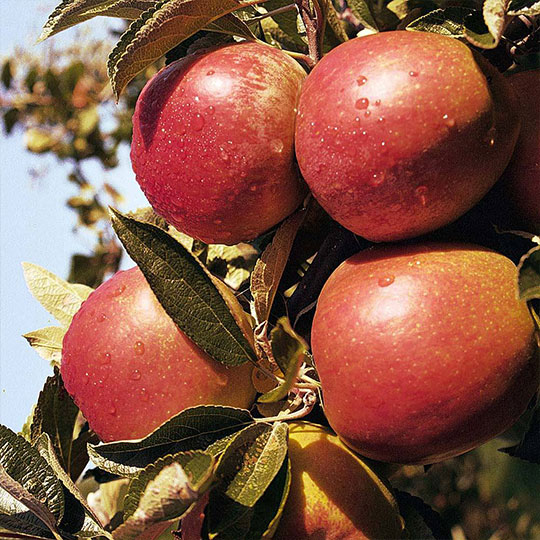
Braeburn
Braeburn apple originated from New Zealand in the late 1950s and is another apple we started to grow before making cider. Braeburn is a heavy cropper of bi-coloured smooth skinned crisp and juicy fruits. In the cooler UK climate however, it struggles to fully ripen and we have to pick late and need a good long warm summer to get the levels of sager needed for cider. Not withstanding this they add good flavour and form a worthy part of our cider.

Cox’s Orange Pippin
The cox is the classic English Apple often regarded as the finest of all dessert apples. It dates back to the 19th century and remains unsurpassed for its richness and complexity of flavour. The apple is great for cider making but beware it needs to be picked and juiced early as with its porous skin, an over ripe cox will have dehydrated and the flesh becomes difficult to press. For this reason, the cox is also unpopular with modern apple trade and you will rarely see a genuine Cox’s Orange Pippin for sale. What you will see being sold as cox are more likely to be a cox variant such as Queen Cox.
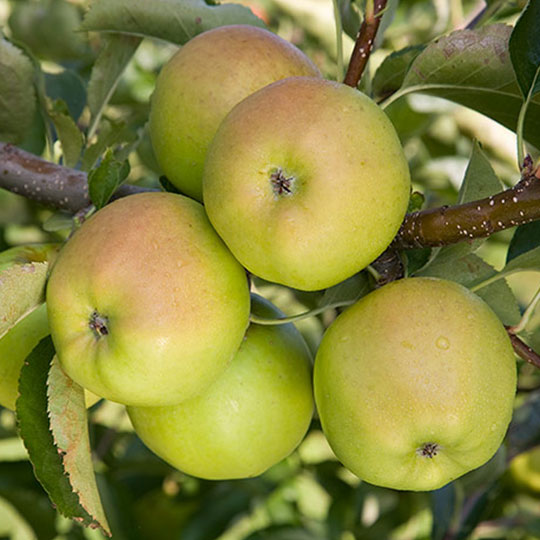
Crispin
We do not grow Crispin but purchase these from our neighbour. Crispin is a versatile large, sweet and juicy apple making it an excellent for both the kitchen and cider. It is a daughter of Golden Delicious where it gets its pale green colour and juiciness. It is not, however, the most flavoursome of apples so is used for its high juice content and sweetness, and blending with less juicy varieties.

Discovery
A much-loved apple but hated by growers. As its name suggest it was discovered in the late 1940s growing wild from seed in a Worcester Pearmain apple orchard. I believe it is a cross between the Worcester and Beaty of Bath which may have been used as a pollinator in the orchard. Why is it hated? well it is susceptible to every bug in the orchard, rots and cracks in wet weather, sun burns in hot weather, is loved by blackbirds and wasps alike, and cannot be stored for long, even in a cold room. It does make good cider though and is usually the first to be picked and juiced. Fermenting in the summer warmth means it brews very quickly and used by some as the first of the season’s cider.

Fiesta
Fiesta, sometimes called Red Pippin, is a modern variety born in Kent in the early 1970s. It is related to cox and albeit lacking some of the cox character and flavour it keeps well and is crisper than cox. It is a medium sized apple which is juicy and ideal for cider producing good flavour and volumes of juice. Our trees are now nearly 25 years old and producing well.

Golden Delicious
Contrary to common belief Golden Delicious is not French but discovered in West Virginia in the USA. We planted a complete row of these trees some 30 years ago but found in our cooler and wetter climate the fruit russeted and failed to go golden, but their flavour was still excellent. There was also a negative reaction to the apple when tasteless French Golden Delicious came onto the market and they became unsellable. Most of our Golden Delicious were therefore regrafted to Fiesta and Queen Cox. Although very juicy, sweet and delicious to eat Golden Delicious make rather bland cider. The few trees we have left are used for blending to improve alcohol level and volume to our cider.
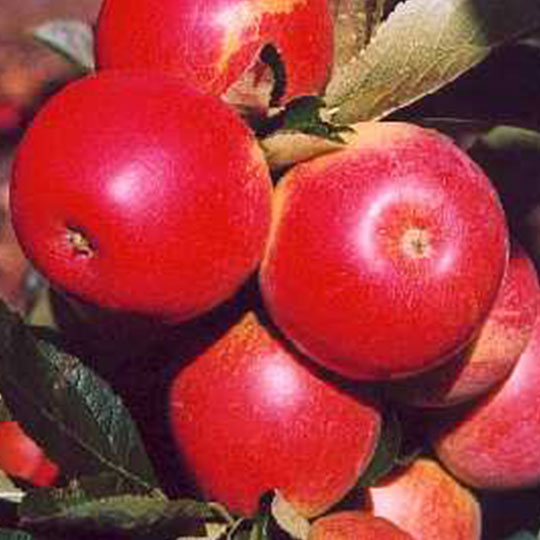
Katy
A Swedish variety developed in 1947 and chosen for its suitability for cider making. Our trees are now well over ten years old and starting to fully crop allowing us to consider a single variety cider. It is a regular heavy cropper and reasonably disease and frost resistant making it a firm favourite. The apples are rosy red and full of juice albeit a little on the small side and make excellent cider.
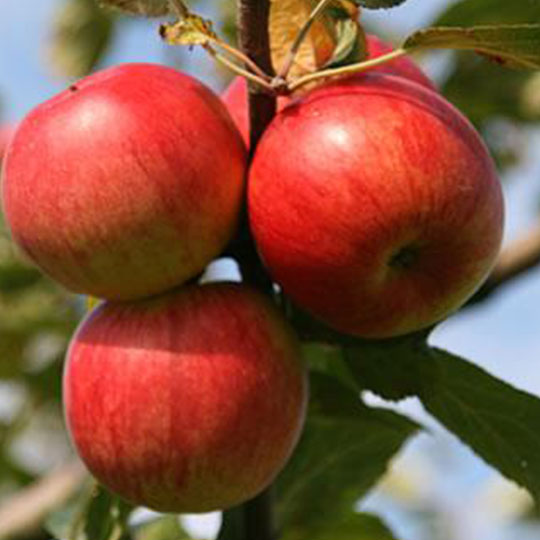
Laxton Fortune
Laxton Fortune is a new variety to our orchard and only just starting to produce. It was developed around 1900 and has cox orange pippin parentage. Its attraction is its disease resistance and better juicing whilst retaining some of the character and flavour of its parent cox orange pippin. We’ll see in a few years’ time but so far it looks good.

Newton Wonder
One of the original trees in the orchard and well over a 100 years old. Developed in Derbyshire in 1887 as a dual-purpose apple (eating and cooking) that stores well. In the days before cold storage the Newton and Bramley were the only apples that would keep well beyond Xmas nearly up to Easter. They make good eating albeit not so sweet and juice well. The downside is the Newton tree only fruits every other year and although juicy it is not sweet or very flavoursome and not a good cider maker. As our newton trees finally succumb to age they are replaced by newer and better varieties for cider.
Other Cider Apples
We have recently planted Kingston Black, Tremlett’s Bitter, Michelin, Dabinett, and Sweet Pethyre. It is still too early for them to start cropping but lookout for Oliver’s Scrumpy in the future.

Queen Cox
Queen Cox is a variant of the original Cox’s Orange Pippin formed by genetic mutation in a Berkshire cox orchard in the 1950s. It has a slightly improved colourisation and the flavour is similar. It stores far better and the apples tend to be bigger making it a natural replacement for what we term the Old English Cox. If you buy a cox today it will undoubtably be a Queen Cox. It is also better for juicing and making into cider.

Royal Gala
A new variety for us and chosen for its good reviews and popularity, but a mistake as Gala is very susceptible to disease, scab in particular which can destroy much of the crop. The apples are fine so we are persevering with the trees we have but planting no more.

Scrumptious
A very new variety with Worcester and golden delicious parentage and developed in the 1980s. Our trees have only just started to crop but so far so good. The apples are very red, sweet and a good size. Early indications are they need to be picked sooner rather than later as there is a tenancy for them to over ripen, become pithy and lose their juiciness.

Spartan
One of our more mature trees put in pre cider days. Notwithstanding this, Spartan makes excellent and strong cider, and was the backbone of our earlier cider making. The apples are dark purple red with pure white crispy flesh and like no other they can be polished to become bright and shining. Unlike other apple in the orchard spartan was developed in Canada in the 1920s and has no UK varieties in its parentage.
Worcester Pearmain
An old variety apple dating back to 1873. Planted in our orchard not long after this and easily over 100 years ago and still fruiting well. The Worcester is a medium sized apple which has a green-yellow background but largely colour red. It is sweet and one of the early ripening dessert apples and usually picked and juiced just after its daughter Discovery. Sadly, the Worcester does not keep too well and for this reason is now falling out of favour as a commercial apple.